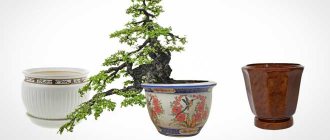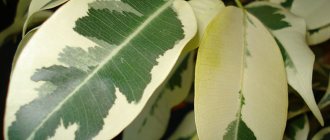General characteristics and varieties of Ficus
Under natural conditions, rubber ficus grows in the forests of India and Indonesia. In nature, these tall trees can reach a height of 30-40 m.
Plants secrete milky sap, which contains a large amount of rubber. At home, this variety of ficus was used for the production of rubber. That's why it received such an unusual name.
At home, this representative of the Mulberry family grows to a height of no more than 2 m. In one year, the stem can lengthen by 40-45 cm. Depending on the variety, its large, alternately arranged leaves can have a single or variegated color. The most famous varieties:
- Black Prince;
- Abijdan;
- Melanie;
- Robusta;
- Belize;
- Tineke;
- Variegata.
Ficus rubber mainly grows in length and rarely forms side shoots. It is almost impossible to see a plant blooming in a room. The elastic tree can only be pollinated by certain types of insects.
Tools and materials
In order not to cause harm to yourself or the plant, you should prepare all the necessary things in advance.
- Sterile garden pruning shears or medical scalpel . To disinfect the blade, you need to lower it into boiling water 2-3 minutes 3-5 minutes .
- A piece of clean cotton cloth or sterile bandage . This material is needed to remove the remaining milky juice on the sections. The fabric should be ironed before use.
- Activated carbon . It is useful for processing sections, but first the tablets should be crushed into a very fine powder. Coal prevents pathogens from entering the “wound” and speeds up its healing.
- Latex gloves . The milky sap of ficus is poisonous to both humans and most domestic animals. To avoid direct contact with it, it is recommended to perform all traumatic manipulations using disposable medical gloves and wash your hands thoroughly after completing work.
Don't forget about the safety of your pets - cats and dogs. During pruning, you should remove them to another room so that they do not accidentally taste the flower juice.
Conditions for keeping Ficus Rubber
Ficus rubber is a hardy plant. But in order to grow well and maintain an attractive appearance, it needs to create the most favorable conditions.
Lighting
When growing an elastic tree, you need to remember that this species came to us from warm countries, where it could receive a sufficient amount of sunlight. When choosing a place for it, you should give preference to a well-lit part of the house, but without burning direct sunlight.
It can grow on a windowsill facing south or north. But with a lack of light, the ficus, like all plants, begins to stretch in height, which affects its decorative effect - the stem lengthens and becomes bare, the leaves become smaller.
Variegated plant varieties require more lighting.
There is an opinion that it is not recommended to plant an elastic tree in a house where people with asthma live.
Air humidity
Air humidity is an important indicator for the room where the plant is kept. A ficus growing in a dry, warm room can also take on a nondescript appearance.
If it is not possible to humidify the air in other ways, during the heating season its leaves must be regularly washed with a spray bottle. In this case, it is recommended to cover the soil in the pot with waterproof material.
Large, shiny ficus leaves are often covered with a layer of dust. This impairs the plant’s breathing, so the leaf blades should be wiped with a damp cloth every few days.
To remove dust from ficus leaves, you should not use industrially produced wet wipes.
Air temperature
Different types of rubber ficus tolerate air temperatures well within the range of 15-300 C. In summer, during active growth, the plant should be kept in a warmer room - 20-300 C. In winter, some varieties can withstand air temperatures dropping to 50 C, which is associated with growth slowdown and transition to a dormant state.
Ficuses must be protected from drafts.
FORMATION OF A TIERED STAMP OF A HOME FICUS
The process can then be represented in the following steps:
- As soon as the ficus reaches the desired height, it needs to be cut off at the top.
- If it is planned to form a two-level trunk, then the ficus crown must be divided into three parts: the 1st and 3rd are located on top, these are the levels that will be spherical, and the 2nd part is between the levels, it is freed from all shoots.
- If it is intended to form 3 levels, then the crown must be divided into five parts. 1,3 and 5 are the upper future levels, which are given the shape of a ball, and 2 and 4 are the distance between them, freed from all shoots.
- You can form the levels from top to bottom, but then the top of the stem cannot be removed until the ficus grows to the desired height.
All care for such a multi-tiered ficus will boil down to cutting off all the overgrown shoots on the bare part of the trunk and removing some young shoots that grow inside the crown and thicken it.
From some ficus trees that have small leaves, for example, Ficus benjamina, you can, if desired, form real green figures in the form of a ball, pyramids, cubes, in the shape of animals and birds.
Rules for caring for Ficus rubbery
Many lovers of potted plants heard in childhood that ficus plants are quite unpretentious and do not require much care. This is true, but like any plant, it has features that must be taken into account when growing.
Caring for rubber ficus includes:
- watering;
- feeding;
- pruning;
- transplant;
- fight against diseases and pests.
There are special aerosols for polishing ficus leaves. Manufacturers claim that they are completely safe and do not harm plants.
Watering
Ficus needs the most water in the summer. The signal for moistening the soil is the drying of the top layer of soil in the pot. On average, the plant is watered 2-3 times a week.
In winter, the rubber ficus drinks noticeably less - no more than once a week. At this time, it slows down its growth and falls into a kind of “hibernation.” To maintain life, it requires a small amount of moisture.
Watering should be moderate. Excessive moisture can cause fungal diseases. In nature, ficus trees can survive short-term drought. Domestic species die if the soil dries completely to a depth of three fingers.
For irrigation, use settled water at room temperature. 30 minutes after moistening the soil, the water in the pan under the pot must be drained.
Top dressing
Ficus rubber needs additional nutrition from spring to late autumn. It is recommended to use complex preparations in liquid form as a top dressing. These can be both organic and mineral fertilizers. They are applied at the root every 2 weeks.
Fertilizers are also available in the form of sticks and tablets. This is the most convenient form of introducing substances into the soil. They just need to be stuck into the ground where the ficus grows. When watered, the tablet itself releases the required amount of the drug in portions.
After transplanting into a new pot, the plant begins to be fed only after a month.
Timing for the procedure
How to make a ficus branch and how complex is such a set of measures? The result will certainly satisfy you if you not only study the necessary principles of the procedure, but also determine what time of year it is best to carry it out. It is possible to get a branched crown from a ficus, but it is better to start pruning in the spring. With the onset of spring, the plant wakes up and all vital processes are activated. If you start pinching the flower at this favorable time, the pruning procedure will not be too stressful for the plant: all the “wounds” will heal instantly. In addition, it is in the spring that young buds form on the plant stem and side shoots develop.
That is why there is no more suitable time for the formation of a ficus crown than the spring period, or rather the end of winter - the beginning of spring. Remember, it is unforgivable to delay with this procedure. If you start pruning your home ficus in mid-spring, the result may not be of very good quality. The thing is that when sap flow is active, shortening the branches can awaken the flower and stimulate its growth as a whole, but the new side shoots will be too thin.
Read also: How to cut branches on a tree
Pruning Ficus rubbery
To form a beautiful ficus crown, some gardeners resort to pruning the plant. The optimal period for the procedure is early spring. In winter, it is not recommended to engage in plant formation, as this can lead to the awakening of only one bud - the ficus will grow sideways.
Trimming rules:
- use a sharp, disinfected instrument - a knife, scissors, etc.;
- wear gloves - the plant sap can cause irritation;
- When removing side shoots, cut them without stumps. Leave the buds on the outside of the stem, remove the inner ones;
- Treat all wounds with fungicide or sprinkle with charcoal.
Removing a small part of the shoot tip will not give the desired result - the plant will begin to grow only in one direction.
Methods of crown formation
There are several ways to form rubber ficus, as a result of which the crown of the plant takes on the form:
- bush;
- arcs;
- standard
Noticeable pruning of the top of the stem (10-15 cm) during the period of active growth of ficus stimulates the development of lateral buds, from which shoots begin to form, and the tree takes on a beautiful bushy shape. To obtain a denser crown, the tops of the side shoots can also be shortened somewhat.
A standard crown shape can be obtained if the ficus has one main stem. Depending on the location, all leaves are removed from a 40-90 cm section of the stem. Trim the top of the plant - 10 cm. This activates the growth of side shoots. As soon as they reach the required length, they are pinched and the buds are removed from the outside of the trunk.
An arched ficus is obtained by bending down the central stem. As soon as the plant reaches the desired length, its top is cut off and secured in a curved form. Side shoots begin to grow actively. Over time, the mount is removed.
The sap of the elastic tree is poisonous. It should be kept away from children and pets.
We form a crown without additional pruning
Forming a crown without pruning is more suitable for young specimens. As ficus branches age, they become less flexible and are more at risk of breaking when trying to bend them.
- Buds that are frozen in growth are stimulated by giving them a vertical position. The kidneys should be directed upward. This position will “wake up” the sprout and force it to develop.
- For uniform development of the plant, the pot with it must be periodically turned around so that the light falls on all branches. Artificial lighting is added to accelerate growth.
- If there is sufficient air humidity in the room, the shoots of the rubber-bearing ficus may develop aerial roots, which must be directed to the ground.
- The formation of a multi-tiered ficus is achieved by planting shoots of different heights in one container.
- Another way to stimulate lateral processes is the use of cytokinins. These are hormonal drugs that slow down the development of plant cells and, accordingly, their aging.
Thus, the ficus remains available for formation for a longer time without pruning.
Rules for transplanting Ficus rubbery
It is impossible to grow any variety of rubber ficus without replanting, as it grows quite quickly and over time its roots become cramped in the pot. For a young elastic tree, the procedure is carried out once a year in the spring-summer period, for an adult - once every few years.
Perennial trees are sometimes not replanted, but simply the top 4-5 cm of soil is changed.
The container for planting the ficus is chosen so that its diameter is 5 cm larger than the previous one and contains drainage holes and a tray.
Transplantation is carried out using the transshipment method:
- the ficus is watered abundantly in advance;
- a layer of drainage is poured into the bottom of the new pot for replanting: pebbles, broken bricks, small pebbles, etc.;
- the plant with a lump of earth is removed from the old pot;
- place it in a larger container;
- The voids in the pot are filled with ready-made soil mixture.
If a container is used to plant a ficus in which a plant has previously grown, it must be disinfected.
Soil requirements
To grow ficus plants, you need to choose loose, fertile soil that will allow water and air to pass through well. The acidity of the substrate should be within 6.5-7 pH.
In flower shops you can buy ready-made soil for planting, but if you decide to make the soil mixture yourself, then it should contain in equal quantities:
- leaf soil;
- turf land;
- river sand;
- peat.
Also, in order to prevent bacterial and fungal diseases, it would be a good idea to add a little charcoal to the mixture.
Care after pruning
There are a number of rules that must be followed in order for the flower formation process to be successful:
- When cutting, stumps should not be left, as they become hotbeds for the development of fungal and bacterial diseases.
- After pruning, a milky sap begins to ooze from the plant, which must be immediately wiped off and the cut area sprinkled with crushed charcoal or any fungicide.
- You can fertilize the ficus after pruning once a month.
Ficus pruning process
- In addition, after pruning, it is necessary to regularly wipe the leaves from dust in order to reduce the risk of infection of the plant.
- A month after the procedure, when the cut sites have completely healed and the side parts begin to actively grow, the flower can be replanted, and the top layer of the substrate can be changed for mature plants. Experts recommend using the transshipment method in order to minimize the risk of injury to the root system during transplantation.
Diseases and pests of Ficus
Ficus rubber is rarely affected by pests and diseases. The species is quite resistant to the most common ailments of indoor plants. Most ficus trees suffer from the careless attitude of gardeners:
- frequent heavy watering, which causes rotting of the vegetative parts;
- drafts;
- direct sunlight burning the leaves of the plant or lack of light;
- planting in an overly large or cramped pot;
- applying excessive amounts of fertilizer.
The leaves on the bottom of the ficus may fall off due to age, which is a natural process.
Occasionally, trees may be favored by scale insects and spider mites. If the number of pests is small, they are removed using folk remedies (for example, a solution of laundry soap). I treat severely affected plants with insecticides.
Ficus propagation
At home, the elastic tree is propagated:
- cuttings;
- layering.
Young plants with monochromatic leaves are easier to obtain than variegated ones. This is due to the fact that the first ones take root faster and easier.
Cuttings are often used to propagate ficus species with monochromatic leaves. Compared to the second method, it is easier, even a beginner can handle it:
- A cutting about 15 cm long is cut from an adult plant;
- leaves on the lower part are removed;
- the cut site is washed with running water until the plant juice completely stops flowing;
- the cutting is placed in a growth stimulator for 24 hours;
- remove from the solution and place in a jar of water;
- After the roots have formed, the plant is planted in a pot.
Ficus rubber cannot be propagated using leaf blades.
Reproduction by air layering is often used to rejuvenate perennial plants or plants that have lost their beauty. But this method is only suitable for actively growing ficus plants.
For propagation by layering:
- select an area in the stem of the plant, remove the leaves;
- an incision is made in place of the leaf blades;
- use a spray bottle to wash off the juice flowing from the stem;
- treat the cut with a root formation stimulator;
- take moss and wrap it around the selected area with cuts;
- wrapped with film. Secure it at the top and bottom;
- care for the ficus as usual;
- after 3 weeks the film is removed. By this time, roots should appear from under the moss.
Ficus with air layering is ready for planting. It is cut with sharp pruning shears and planted in a pot.
Ficus rubber is perfect for those who want to liven up their home with plants, but cannot spend a lot of time caring for them. Therefore, it is not difficult to explain why it has again become popular among the townspeople. An elastic tree with smooth green leaf color is the easiest to care for: it can tolerate lower temperatures, takes root more easily, is less demanding in terms of maintenance conditions, etc. But variegated varieties are considered more decorative.
marked ,
Your opinion is very important to us. Please rate the article: rated 3 , rating: 4.67 out of 5
See also related articles
Myrtle tree: care at home
How to grow chestnut from a nut at home in a pot
How to grow pomegranate from seeds at home to produce fruits
How to grow lemon from a seed at home with fruits: step by step
How to grow cedar from a nut at home: photos, step by step
Tabernemontana: care at home
How to grow dates from seeds at home in a pot
How to grow mangoes from seeds at home, in a pot: for beginners
How to grow an avocado from a seed at home: in a pot, for beginners
Add a comment Cancel reply
You must be logged in to post a comment.
✿ Alphabetical index
✿ Categories
- Houseplants
- Bromeliads
- Decorative foliage
- Trees and shrubs
- Orchids
- Succulents
- Blooming
- Perennial
✿ Popular articles
- How to grow chestnut from a nut at home in a pot
- Clematis: care and cultivation in the garden
- How to grow lemon from a seed at home with fruits: step by step
- Campanula: home care after purchase and transplantation
- How to grow pomegranate from seeds at home to produce fruits
- Decembrist flower: care at home, how to water correctly
✿ Latest comments
- Lyudmila on How to grow a lemon from a seed at home with fruits: step by step
- Tatyana on Tillandsia Anita: care at home
- LOVE for the entry Tulips: care and cultivation in the garden
Copyright © 2018-2021 GARDENER'S BOOK.
0+ By using bookgardener.ru you accept the terms of the USER AGREEMENT. Copyright for the posted materials belongs to the editors of the online magazine. When reprinting and using materials, an active hyperlink to BookGardener.ru is required
Formation of an unusual crown
How to form an unusual type of rubber ficus? Everything is very simple. This procedure should be done not with a single plant, but by planting several ficus plants in one pot at once. Flowers should be young, equally developed and the average height should not exceed 15 cm.
All side shoots must be removed, and the trunk must be given the desired shape as the plant grows. The main rule: weaving should be done freely, since over time the trunks will thicken. To form a spiral, you will need two plants in one pot, for a “braid” - at least three.
You need to start weaving when all the plants in the pot have reached a certain height (usually 13-15 cm). Each subsequent turn must be done as the plant develops. To prevent the braid from unraveling, the trunks need to be tied up. The threads should be soft, ideal if you take woolen ones. They need to be bandaged every two months. If necessary, you can install a support.











